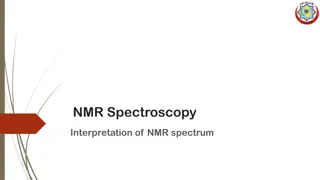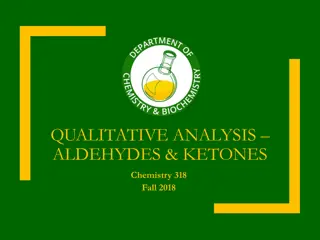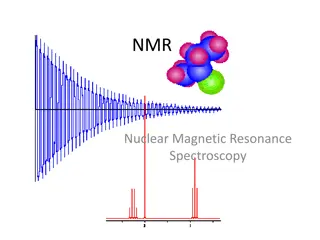Understanding the Basics of 13C NMR Spectroscopy
Nuclear Magnetic Resonance (NMR) Spectroscopy is a powerful analytical tool used in chemistry to study the structure of molecules. This summary focuses on the application of 13C NMR spectroscopy, which provides valuable information about carbon atoms in a compound. The low natural abundance of carbon-13 requires sensitive instruments for detection, but the technique offers detailed insights into natural products, biological molecules, and polymers based on unique chemical shifts. Analyzing 13C NMR spectra involves matching signals to specific carbon atoms based on their chemical environment, providing a deeper understanding of molecular structures.
Download Presentation

Please find below an Image/Link to download the presentation.
The content on the website is provided AS IS for your information and personal use only. It may not be sold, licensed, or shared on other websites without obtaining consent from the author. Download presentation by click this link. If you encounter any issues during the download, it is possible that the publisher has removed the file from their server.
E N D
Presentation Transcript
NMR Spectroscopy 13C NMR spectroscopy
Nuclear Magnetic Resonance Spectroscopy 13C NMR 2 After hydrogen, the most useful atom providing information is carbon-13. The overall intensity of a 13C signal is about 6400 times less than the intensity of an 1H signal. The chemical shift ranges over 220 ppm. The reference compound is TMS. Natural carbon contains about 1% of this isotope so the instruments for its detection need to be sensitive and spectra will take longer to record. Only the chemical shift is important as each spectrum gives only single lines for each chemically equivalent carbon. Carbon-13 nmr has wide applications in the study of natural products, biological molecules and polymers.
Nuclear Magnetic Resonance Spectroscopy 13C NMR 3 a d ( 2) higher than ( 1) 2 1 c a b b c d
Nuclear Magnetic Resonance Spectroscopy 13C NMR 4 a A score value depends on the type of C atom attached to the analysed carbon atom. It can help to know which signal matches with its respective shift. For example: A score value of a is 3 because it attaches to b (tertiary carbon 3) A score value of b is 4 because it attaches to (two primary carbon 1 for a) and a secondary carbon 2 for c .etc. a 1 d 1 b d b c a c 1 3 4 2 2 4 3
Nuclear Magnetic Resonance Spectroscopy 13C NMR 5 a A score value depends on the type of C atom attached to the analysed C. It can help to know which signal matches with its respective shift. For example: A score value of a is 3 because it attaches to b (tertiary carbon 3) A score value of b is 4 because it attaches to (two primary carbon 1 for a) and a secondary carbon 2 for c .etc. 4 3 5 3 2 a b c e d 2 3 2 1 1 c bd a e Sometimes : 1 > 2 > 3 Increase
Nuclear Magnetic Resonance Spectroscopy 13C NMR 6 The C-13 NMR spectrum of pentane shows 3 signals with chemical shifts 14, 23, and 34 ppm. Match the carbon atoms with their respective shifts. a b 2 2 c 1 2 1 b b a a c C atom a b c Score value 2 3 4
Nuclear Magnetic Resonance Spectroscopy 13C NMR 7 The C-13 NMR spectrum of 3-methylpentane shows 4 signals with chemical shifts 11, 19, 29 and 36 ppm. Match the carbon atoms with their respective shifts. b a a 3 1 1 b 2 b 2 c a d 1 c d C atom a b c d Score value 2 4 5 3
Nuclear Magnetic Resonance Spectroscopy 13C NMR: Effect of electronegativity of attached atoms 8 Environment C - OH C - N C - Cl or C - Br Chemical shift (ppm) 50 - 65 35 - 65 30 - 70 EN 3.44 63 3.04 42 3.16 45 2.96 34 2.66 7 (High ) C-O > C-N > C-Cl > C-Br > C-I (low )
Nuclear Magnetic Resonance Spectroscopy 13C NMR 9 Which carbon atom will have a higher chemical shift, a or b? 45 ca 11 Score value 26 b b 60 3 35 3 2 II I When C atom is in the interior of a chain, it usually has a higher than an atom at the end of a chain CH3 in (II) is closest to Cl atom, so it will be deshielded (26 ppm) CH3 in (I) is too far from Cl, so it will be shielded (11 ppm) The score value of c (C atom next to a ) is 3 BUT Cl atom has the powerful EN effect on a which makes appear at 45 ppm while c at 35 ppm. So, we depended on the proximity to identify the signals.
Nuclear Magnetic Resonance Spectroscopy 13C NMR Which carbon atom will have a higher chemical shift, a or b? 10 a 33 c d 35 b Score value 2 3 3 2 Carbon a will have a lower value than b although it attaches to Br atom because of the EN value of Br is less than of Cl atom NOTE: we have to be aware when we deal with any alkyl halide, and notice if we have a powerful halogen like Cl, the proximity effect will dominate. While, if we have Br atom in the compound, the score value will dominate.
Nuclear Magnetic Resonance Spectroscopy 13C NMR Which carbon atom will have a higher chemical shift, a or b? 11 b a Score value 3 3 Both a and b have the same score value, BUT b will be higher than a because of the EN values of (C = 2.55) and (I = 2.66), so I will not affect too much on C atom. 7 14 Iodine has the effect to lower the value for the attached carbon.
Nuclear Magnetic Resonance Spectroscopy 13C NMR: (C-O) 12 a b 58 63 2 1 1 2 3 3 d 82 69 c 3 2 1 6 71 2 2 e f 2 3 73 1 1 1 Score value 4 5 Chemical shift Chemical shift (C-O) = (50-100) ppm
Nuclear Magnetic Resonance Spectroscopy 13C NMR: (C-O) 13 The C-13 NMR spectrum is shown below for a compound with a molecular formula C6H14O, propose a structure for the molecule. 1. Look at the possible functional groups locations. 2. (C-O) alcohol or ether (50-100) ppm 3. It can not be an ester because it should has two oxygen atoms 4. It can not be an aldehyde or ketone because there is no a significant signal at (150-200) ppm. 5. It is impossible to have a (C=C) or a ring because they appear at (100- 150) ppm. C6H14O
Nuclear Magnetic Resonance Spectroscopy 13C NMR: (C-O) 14 The C-13 NMR spectrum is shown below for a compound with a molecular formula C6H14O, propose a structure for the molecule. C6H14O Calculate index of hydrogen deficiency (IHD). =2 ? +2 #? ??? 2 =2 6 +2 14 ??? 2 = 0 ??? IDH = 0 means NO (=), ( ), or ring IDH = 1 means (=), or ring IDH = 2 means ( )
Nuclear Magnetic Resonance Spectroscopy 13C NMR: (C-O) 15 The C-13 NMR spectrum is shown below for a compound with a molecular formula C6H14O, propose a structure for the molecule. C6H14O In alcohols, only one signal will appear between (50-100) ppm, while in ethers we will find two. So, we have an ether. Now, focus on the number of signals, as we have six carbon atoms and four signals, that means we have an equivalent atoms which give one signal.
Nuclear Magnetic Resonance Spectroscopy 13C NMR: C6H14O 16 X X 6 6 X X 2 5 Number of signals 4
Nuclear Magnetic Resonance Spectroscopy 13C NMR: (C-O) 17 The C-13 NMR spectrum is shown below for a compound with a molecular formula C6H14O, propose a structure for the molecule. a Equivalent atoms give a one high peak, so a appears at 23 ppm, d will be the lower (16 ppm) according to the score values. a C6H14O a b d c a Both b and c are attached to O, and that gives the possibilities to find absorbance between 50 and 100 ppm. According to the score values, b is the highest (74 ppm) than c (55 ppm). Atom a b c d Score value 3 5 4 2 c d b
Nuclear Magnetic Resonance Spectroscopy 13C NMR: (C C) (50-100) ppm (70-100) ppm 18 a a b b Two signals 3 75 75 3 Normally, all methyl groups appear at (10-20)ppm, BUT the ( ) has a strong effect on the values of C atoms attached (alpha carbon). It reduces of methyl group to 3 ppm.
Nuclear Magnetic Resonance Spectroscopy 13C NMR: (C C) (50-100) ppm (70-100) ppm Calculate the score value. We can differentiate between b and c by the score values, where c is higher in value (4) than b (3). Both a and d are attached to the ( C), BUT they have different score values, a (2) and d (3). According to the score values, d should be higher in value than e, BUT because of the closeness of d to ( C), the triple bond will decrease the chemical shift of d to be 13 ppm. While e will appear at 14 ppm. 19 e d 3 e c d b 4 2 a 3 2 c b a
Nuclear Magnetic Resonance Spectroscopy 13C NMR: (C C) (50-100) ppm (70-100) ppm Determine the number of signals Compare between a and b by score value 20 c e f d b a 3 4 3 2 NOTE : chemical shifts ( ) of internal alkynes are fairly close, while they are not so close in terminal alkynes, by this way, we can differentiate between terminal and internal alkynes. 4 2 Chemical shift 68 85 18 31 22 14 decf a b Calculate the score values for c, d, e, and f Carbon c and d have the same score value, BUT c will be lower in ( ) than d because it is closer to the ( C).
The two C-13 NMR spectra are shown below corresponded to different constitutional isomers of C6H10, propose a structure for each spectrum. 21 II I Calculate index of hydrogen deficiency (IHD). =2 6 +2 10 ??? 2 = 2 That means we have either ( ) or 2(=) ??? Because the(C=C) appears at (100-150)ppm, it is impossible to have an alkene here SO, we have an alkyne
The two C-13 NMR spectra are shown below corresponded to different constitutional isomers of C6H10, propose a structure for each spectrum. 22 II I 1. Number of signals is 4 (equivalent C) 2. The last two signals are not close (TERMINAL) alkyne 1. Number of signals is 6 (no equivalent C) 2. The last two signals are too close (INTERNAL) alkyne
The two C-13 NMR spectra are shown below corresponded to different constitutional isomers of C6H10, propose a structure for each spectrum. 23 I Six signals Six signals Three signals Five signals
The two C-13 NMR spectra are shown below corresponded to different constitutional isomers of C6H10, propose a structure for each spectrum. 24 e 1. Carbon a will be the lowest value (3) because it attaches to ( C) directly. 2. According to the score value, c will appear at higher chemical shift (79 ppm) than b (75 ppm). 3. Although d has a higher a score value than e, it will appear at low value (21 ppm), while e (23 ppm) because of the ( ) effect. 4. Carbon f is too far than ( C), so it will appear at normal value (14 ppm). f d d f c e b 4 2 3 a 4 3 a 2 c b
The two C-13 NMR spectra are shown below corresponded to different constitutional isomers of C6H10, propose a structure for each spectrum. 25 II Four signals Five signals Four signals
The two C-13 NMR spectra are shown below corresponded to different constitutional isomers of C6H10, propose a structure for each spectrum. 26 1. Calculate the score values 2. Carbon b will appear at (93) ppm, while a will appear at (67) ppm. 3. Carbon c will be lower in value than d although it has high score value because of the ( ) effect. 4. Also, we can detect d in the chart because it contain three equivalent carbons which give a big single signal. d d a d b c d Atom a b c d Score value 2 5 5 4 a c b
Nuclear Magnetic Resonance Spectroscopy 13C NMR: (C=C) (100-150) ppm 27 d c b d e b a c e a Score value 2 3 4 3 2 Double bond does not have the same effect of triple bond, that means it does not lower the chemical shift value at (alpha carbon)
Nuclear Magnetic Resonance Spectroscopy 13C NMR: (C=C) (100-150) ppm 28 2 methyl-1-butane has five signals with chemical shifts 12, 22, 31, 109, and 148 ppm. Assign a chemical shift to each carbon atom. e Carbon a will have a lower chemical shift (109 ppm) than b (148 ppm) because it is terminal according the score values, we can detect the other carbon atoms, c, d, and e 22 d b a c 148 12 31 109 C atom c d e Score value 4 2 3
Nuclear Magnetic Resonance Spectroscopy 13C NMR: (C=C) (100-150) ppm 29 The C-13 NMR spectrum for C8H10 is shown below, propose a structure for this molecule. Calculate index of hydrogen deficiency (IHD). =2 8 +2 10 ??? 2 = 4 ??? IDH value means that we have either 4(=) or a ring which they are appear at (100- 150)ppm. So we need to propose some structures which may fit with our outcomes.
Nuclear Magnetic Resonance Spectroscopy 13C NMR: (C=C) (100-150) ppm 30 The C-13 NMR spectrum for C8H10 is shown below, propose a structure for this molecule. Three signals Four signals Three signals Five signals
Nuclear Magnetic Resonance Spectroscopy 13C NMR: (C=C) (100-150) ppm 31 The C-13 NMR spectrum for C8H10 is shown below, propose a structure for this molecule. molecule. 1. It is clearly to find a at (21) ppm 2. There is four signals that corresponds to c, and two for b. 3. So c has to appear at (129) ppm, and b at (135) ppm. 4. SO, height plays an important role to determine benzene rings and its substitutions. 5. NOTE: The more carbon atoms are chemically equivalent will appear in a taller peak than the other ones. The C-13 NMR spectrum for C8H10 is shown below, propose a structure for this c c a c b b c a c b a
Nuclear Magnetic Resonance Spectroscopy 13C NMR: (C=O) (150-220) ppm 32 Chemical shifts (205-220) (190-205) (175-185) (165-175) Chemical shifts (209) (203) (181) (170) Chemical shifts (198) (192) (172) (167)
Nuclear Magnetic Resonance Spectroscopy 13C NMR: (C=O) (150-220) ppm 33 The C-13 NMR spectra for two constitutional isomers of C4H8O2 are shown below, identify the functional groups corresponded for each spectrum. I II Calculate index of hydrogen deficiency (IHD). =2 4 +2 8 = 1 means we have (=) bond or a ring ??? ??? 2 Both charts include a signal in the range (150-220) ppm, which indicates the existence of (C=O). So we do not have an alkene or a ring.
Nuclear Magnetic Resonance Spectroscopy 13C NMR: (C=O) (150-220) ppm 34 The C-13 NMR spectra for two constitutional isomers of C4H8O2 are shown below, identify the functional groups corresponded for each spectrum. I II (C=O) means: A ketone An aldehyde A carboxylic acid An ester In esters, a signal should appear around 60 ppm, that is clearly noticed in (II) only, which gives an indication that (II) is an ester. Compound (I) is a carboxylic acid as its spectrum does not include a signal at 60 ppm. (205-220) ppm (190-205) ppm (175-185) ppm (165-175) ppm
Nuclear Magnetic Resonance Spectroscopy 13C NMR: Proton coupled mode N+1 (splitting) 35 All the spectra that we have considered were based on (broadband decoupled mode), where all the signals appeared as singlets. Another mode we have to be familiar with is (proton coupled mode (N+1)), which shows splitting not from adjacent hydrogens BUT from the hydrogens that directly attached to the carbon atom that will split (+1). Example: What type of splitting in the following compound? Carbon a attached to 3H (n=3), so (n+1) = 4 (quartet) Carbon b attached to 1H (n=1), so (n+1) = 2 (doublet) Carbon c attached to 2H (n=2), so (n+1) = 3 (triplet) Carbon d attached to 3H (n=3), so (n+1) = 4 (quartet) d a c b
Nuclear Magnetic Resonance Spectroscopy 13C NMR: Proton coupled mode N+1 (splitting) 36 All the spectra that we have considered were based on (broadband decoupled mode), where all the signals appeared as singlets. Another mode we have to be familiar with is (proton coupled mode (N+1)), which shows splitting not from adjacent hydrogens BUT from the hydrogens that directly attached to the carbon atom that will split (+1). Example: What type of splitting in the following compound? a c d d a c b b























